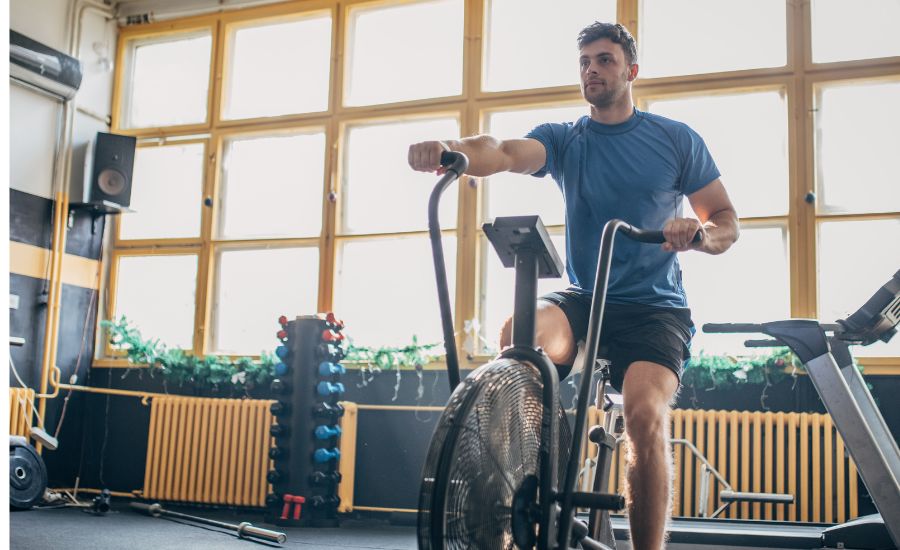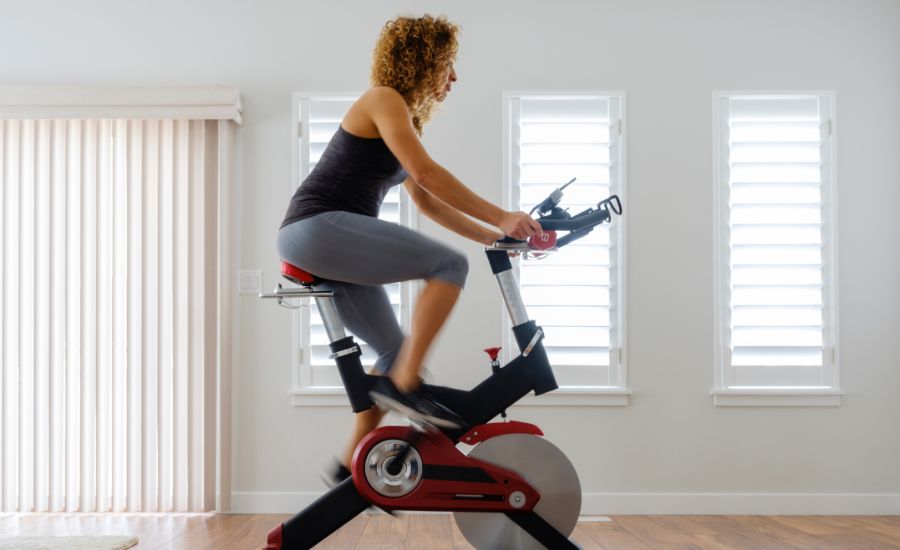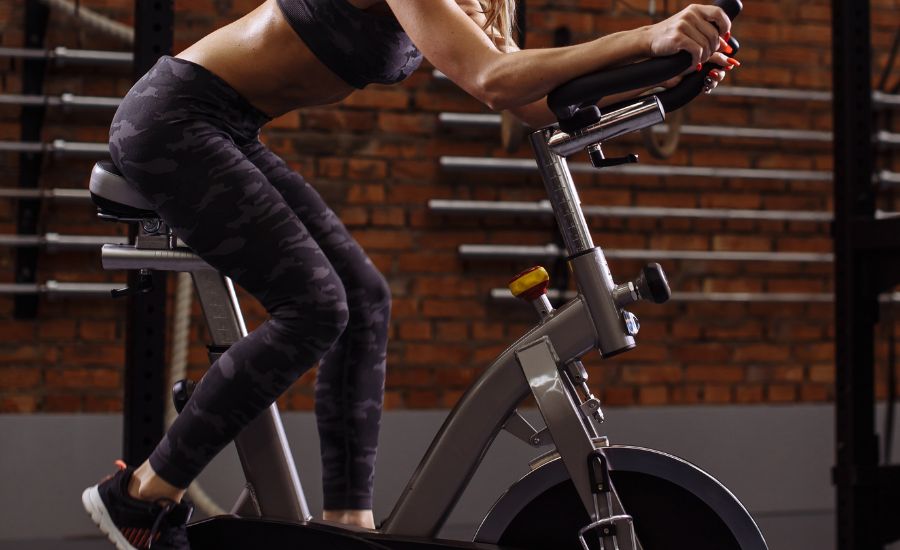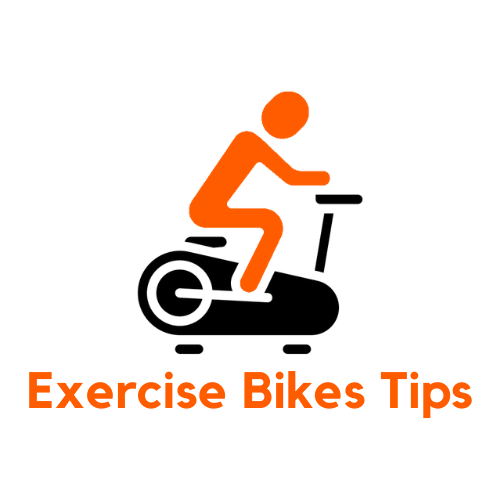What muscles does exercise bike work? The exercise bike, also known as a stationary bike, has become a popular choice for individuals looking to engage in cardiovascular workouts within the comfort of their homes or at the gym. This versatile fitness equipment provides a low-impact and effective way to burn calories, improve cardiovascular health, and tone various muscle groups.
Whether you choose a traditional upright exercise bike, a recumbent bike, or an indoor cycling bike, the benefits and muscles worked remain relatively consistent. In this article, we will explore what muscles does exercise bike work, provide suggestions for different fitness goals, discuss additional benefits, and offer insights on the time it takes to build muscles through this form of exercise.

Upper body muscles
While primarily exercise bike work the lower body muscles, certain upper body muscles also play a role in the workout. Although the intensity may not be as high as with lower body engagement, upper body muscles contribute to maintaining stability and balance during your ride.
Arm muscles
Arm muscles, particularly the biceps, and triceps, are the one of the upper body’s muscles involved during riding an exercise bike.
As you grip the handlebars, the biceps brachii muscles in the front of the upper arm contract to flex the elbow joint.
The triceps brachii muscles at the back of the upper arm assist in extending the elbow during the pushing phase of the pedal stroke.
Upper back muscles
The muscles of the upper back, including the rhomboids and trapezius, play a role in maintaining an upright posture while riding an exercise bike. These muscles help stabilize the shoulder blades and promote proper alignment of the upper body during the workout.
Abdominal muscles
While exercise bikes primarily focus on the lower body, they still engage the abdominal muscles to a certain extent. The abdominal muscles, including the rectus abdominis, external obliques, and internal obliques, work to stabilize your core and maintain an upright posture during your ride.
This engagement helps to strengthen and tone the abdominals over time. However, it’s important to note that exercise bikes alone may not provide a comprehensive abdominal workout, and additional exercises targeting the core muscles may be beneficial for overall development.

Lower body muscles
The lower body is the primary focus of exercise bike workouts, as they provide an excellent opportunity to target and strengthen various muscle groups.
Understanding which muscles are worked during these exercises can help you optimize your workout routine and target specific areas.
Quadriceps
Located in the front of the thighs, the quadriceps muscles are the primary muscles worked during exercise bike sessions.
These muscles consist of the vastus lateralis, vastus medialis, vastus intermedius, and rectus femoris. They contract to extend the knee joint as you push the pedals downward.
Hamstrings
Situated at the back of the thighs, the hamstrings work as antagonists to the quadriceps. The group comprises the biceps femoris, semitendinosus, and semimembranosus.
During the upward phase of the pedal stroke, the hamstrings contract to flex the knee joint.
Gluteal muscles
The gluteal muscles, including the gluteus maximus, gluteus medius, and gluteus minimus, are engaged during each pedaling.
These muscles, collectively referred to as the glutes, play a crucial role in hip extension.
As you push down on the pedals, the glutes contract to propel the body forward.
Calf muscles
The calf muscles, specifically the gastrocnemius, and soleus, are activated during the downward phase of the pedal stroke. As you push against resistance, the calf muscles contract to extend the ankle joint, allowing you to maintain control and power throughout the movement.

Hip flexors
The hip flexors, including the iliopsoas and rectus femoris, play a secondary role in exercise bike workouts. The hip flexors assist in flexing the hip joint during the upward phase of the pedal stroke.
They also let you move your upper body forward. Workouts on stationary bikes enable the hip flexors to work with other lower-body muscles.
Thigh muscles
Exercise bikes effectively target the thigh muscles, including the quadriceps and hamstrings. As you pedal, the quadriceps, located in the front of the thighs, contract to extend the knee joint and push the pedals downward. This action engages and strengthens the quadriceps, contributing to overall thigh muscle development.
Additionally, the hamstrings at the back of the thighs act as antagonists, contracting to flex the knee joint during the upward phase of the pedal stroke.
Understanding the involvement of specific muscle groups can help you adjust your resistance levels and customize your exercise bike workouts to target different areas of the lower body for optimal muscle development.
Please note that individual muscle engagement may vary based on factors such as cycling technique, resistance levels, and individual biomechanics.
Exercise bike workout routines
To achieve specific fitness goals or train a particular muscle group, it’s essential to tailor your exercise bike workouts accordingly. Whether you aim to build muscle, tone and strengthen, or increase overall endurance, here are some workout suggestions.
Muscle building
To build muscle mass, incorporate higher resistance levels on your exercise bike.
Perform interval training by alternating between high-intensity sprints and lower-intensity recovery periods.
This approach stimulates muscle growth and strength development.
Toning and strengthening
To tone and strengthen your muscles, maintain a moderate resistance level and a steady pace. Aim for longer-duration workouts, gradually increasing the intensity and duration over time. This approach promotes muscle endurance and definition. You also can add some cardio workout to lose weight faster.

Bulking
If your goal is to bulk up and increase muscle size, consider combining your exercise bike workouts with resistance training. Perform exercises such as squats, lunges, and leg presses to complement your lower body-focused workouts on the bike. Incorporate upper body exercises such as bicep curls and shoulder presses during rest intervals for overall muscular development.
Other benefits of exercise bike
In addition to the muscular benefits, riding an exercise bike offers numerous advantages for overall health and well-being.
Cardiovascular health
Regular exercise bike sessions contribute to improved cardiovascular fitness, strengthening the heart, and improving blood circulation.
Weight loss
Riding a stationary exercise bike helps burn calories and can assist in weight loss efforts when combined with a balanced diet.
Low impact
Unlike high-impact activities, exercise bikes provide a low-impact workout that is gentle on the joints, reducing the risk of injuries.
Convenience and accessibility
Stationary exercise bikes are readily available, making them a convenient fitness option for individuals of all fitness levels and abilities.
Building muscles on the exercise bike
Building muscle on an exercise bike takes time and consistency. The rate of muscle growth varies depending on factors such as individual genetics, training intensity, and nutrition.
It’s important to set realistic expectations and focus on progressive overload, gradually increasing the resistance and duration of your workouts.
It is also important to remember what muscles does a stationary bike work.
To maximize muscle development on the stationary bike, consider the following advice:
- Incorporate resistance. Adjust the resistance levels on your exercise bike to challenge your muscles progressively. Gradually increase the resistance as your strength improves.
- Vary your workouts. Mix up your exercise bike workouts by incorporating interval training, hills, and varying speeds. This approach helps target different muscle groups and prevents plateauing.
- Maintain proper form. Pay attention to your posture and form during exercise bike workouts. Maintain an upright position with a slight forward lean, engaging the core muscles and avoiding excessive stress on the back.
- Support your workouts. Proper nutrition, including sufficient protein intake, is essential for muscle growth and recovery. Additionally, prioritize rest and recovery to allow your muscles to repair and rebuild.
- Body fat scale. If you want to track the progress in building the muscles you can use the body fat scale, which will help you to stay motivated.

Conclusion
In conclusion, the stationary exercise bike offers an effective and versatile way to engage both the upper and lower body muscles. By incorporating targeted workout routines and maintaining consistency, you can build strength, tone muscles, and achieve your fitness goals while enjoying the numerous benefits of this popular fitness equipment.
Remember to consult with a healthcare professional before starting any new exercise program, especially if you have pre-existing medical conditions or injuries. We hope that our article helped you to figure out which muscles does a stationary exercise bike work.
Frequently asked questions
Does a stationary bike burn belly fat?
While riding a stationary bike workout can contribute to overall weight loss, it’s important to note that spot reduction of fat is not possible. This means that specifically targeting belly fat with a stationary bike is unlikely to yield significant results. However, engaging in regular cardiovascular exercises like riding a stationary bike can help burn calories and reduce body fat overall, including in the abdominal area.
Is 30 mins a day on a stationary bike enough?
Thirty minutes of exercise on a stationary bike can be a good starting point for cardiovascular fitness. It provides a moderate aerobic workout and can help increase your heart rate, burn calories, and improve overall health.
However, the effectiveness of this duration depends on various factors such as your current fitness level, intensity of the workout, and personal goals. For more substantial benefits, gradually increase the duration or intensity of your indoor cycling bike workouts over time.
Does a stationary bike build muscle?
Stationary bikes primarily target the lower body muscles, including the thighs, hamstrings, calves, and glutes. While it can help strengthen and tone these muscles, the resistance offered by most stationary bikes may not be sufficient to build significant muscle mass. To build muscle, incorporating strength training exercises that specifically target desired muscle group is generally more effective.
Does stationary bike tone your body?
A stationary bike workout can contribute to toning your body, particularly the lower body muscle group that includes thighs, hamstrings, calves, and glutes. Regular cycling workouts on a stationary bike can help improve muscle definition and create a leaner appearance.
However, to achieve a well-rounded and balanced physique, it’s beneficial to combine stationary bike workouts with exercises that target another muscle group, such as the upper body and core.

